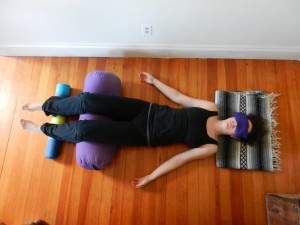Some yoga teachers worry about inversions, others worry about forward folds, I am obsessed with Savasana.
Yes, you could do some serious damage in headstand and a forward fold with a herniated disk is terrible. These are plenty of things to worry about. As a teacher I’m trained to always be looking for the person in the room causing themselves pain. That carries over into restorative and resting postures as well.
I teach Savasana a few times a year and do a quick review every class. But people still don’t seem to get it. My best and most faithful students continue to ask me questions that reveal I have yet to clarify the whole picture of this complicated posture. So here I am, in the written word, off the mat determined to get out my opinion on this most beloved posture.
Okay, for all you non-yogis, Savasana or Corpse Pose, is the lying-on-your-mat-at-the-end-of-class posture. Just like nap time we encourage covering up with a blanket.
I believe in long savasanas. The hallmark of my Friday class is a 15-20 minute final relaxation that makes the regulars swoon and makes the newcomers a little nutty. Most teachers don’t expect you to lie still that long—I encourage/require it. For lots of people 2-3 minutes of stillness sounds like an eternity. Some people can’t lie on their back for more than 30 seconds without falling asleep, others can’t be still without fidgeting, others can’t make their mind stop spinning.
Over the years of teaching I’ve discovered that it is helpful to think of learning/teaching savasana as a complicated physical posture. Here are the particulars.
Set Up
Years ago I attended an excellent workshop with Judith Hanson Lasater. Truth be told I don’t remember what the workshop was on, I just remember she spent at least two hours teaching us how to teach savasana.
The highlight of the class was watching her put one of the workshop participants into savasana. She had her lie on her mat with the 50 students in the room hovering around watching her. The woman went into her typical corpse pose and Judith asked her how she felt. I remember the woman answering “it feels fine” or something to that extent. Then she went to work propping her head, her neck, her knees, ankles, covering her eyes and covering her in a blanket. With each addition she would ask the woman if she was comfortable. Her answers transitioned from “it feels fine” to “yes” to “ummm” to a tiny, bitty nod of the head. The woman had dropped into a non-verbal space in front of 50 onlookers in about 90 seconds.
This picture of me in savasana is a good start. The support under the knees puts less pressure on the low back and sacrum. The support under the ankles puts less pressure on the feet and the hips. The support under the neck and head not only are comfortable, they roll the pineal gland into dominance over the pituitary. Gently pressing you out of the sympathetic nervous system. Um hmm, just with a lift of the skull. What this picture lacks (so you can see the rest) is a cover. A blanket over the top helps contain the whirling prana close to the body while you rest and prevents leakage of the prana while at rest. It also allows the body to feel safe and warm enough as it drops into lower states of consciousness and drastically cools down.
Stages
Now in every pose some of us are going to be able to jump in to a step further down the list. Not all of us will start at #1. But the sequence is important to know for those who think savasana is impossible. Like the rest of the practice we each have our portion of the posture to master.
- Sitting back against the wall, eyes open, peacefully.
- Lying on the ground, eyes open, peacefully.
- Lying on the ground, eyes open, without fidgeting for long moments, slowly building up endurance.
- Lying on the ground, eyes open, still for the whole time.
- Lying on the ground with eyes closed for long moments, slowly building up endurance and working on not falling asleep.
- Lying on the ground, eyes closed and still the whole time.
- Lying on the ground, eyes closed and still and thinking about and sensing the breath or the body.
- Lying on the ground, eyes closed, still, fully relaxed, enjoying the stillness and letting the mind wander.
- Lying on the ground, eyes closed, still, fully relaxed, letting attention of the body and breath begin to fade and letting the mind wander a little.
- Lying on the ground, eyes closed, still, little to no awareness of the body, consistently bringing the mind back towards stillness and working towards a quiet mind.
- For some people staying awake is an issue, for these people I strongly encourage them to sleep (they obviously need it) as they get more rested it will become easier to relax without dosing off.
- For some people being still and aware of the body may happen for years as the whole practice because being aware the body is challenging enough.
- For some people being still and quiet is such a relief they just drop in like it is a homecoming.
Final thoughts
Pregnant women take savasana curled up on their left side to allow for best oxygen flow to the baby and to their own heart. Some people have to drastically prop the head above the heart for blood pressure or vertigo reasons. I, for one, often take savasana on my side because of a loose sacrum. Sometimes it is helpful to remember that the end results of extreme integration and relaxation are far more important than the traditional corpse pose. If you can’t make it work, ask your teacher and find a way to be blissful. You deserve it.
Photo by Sara Rauch